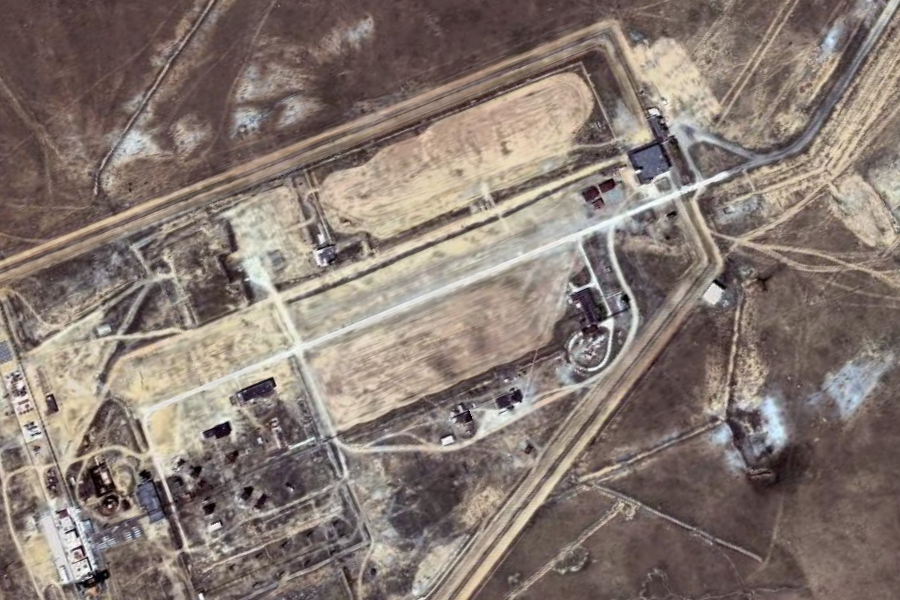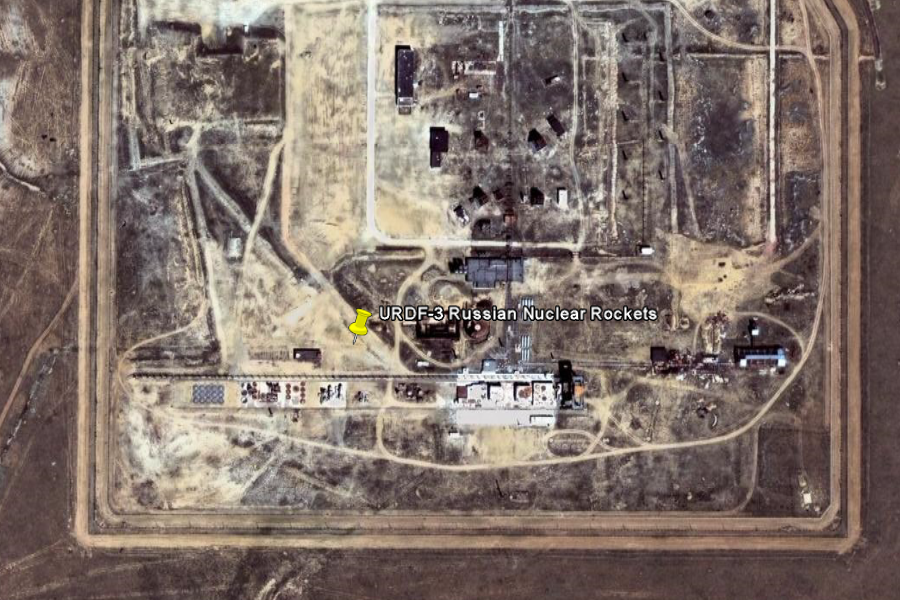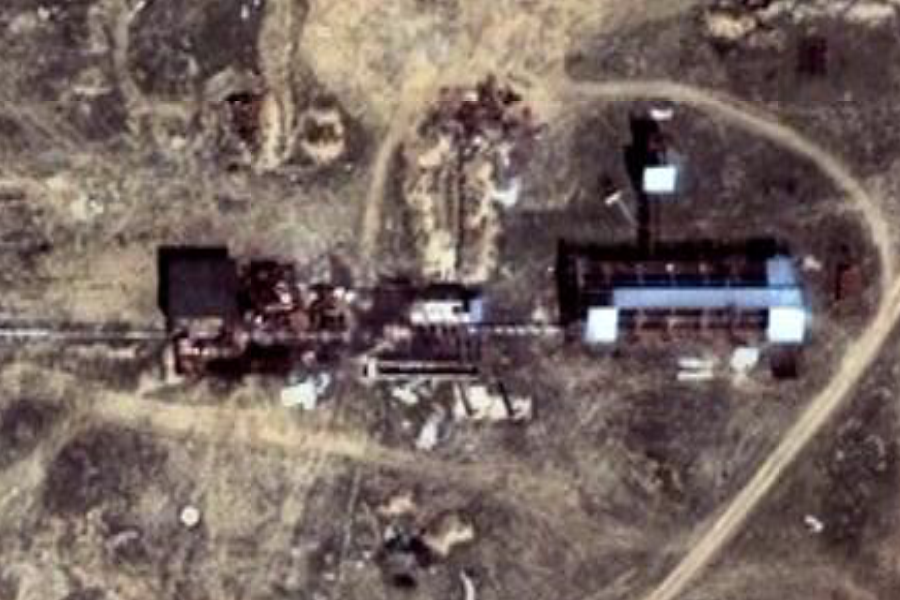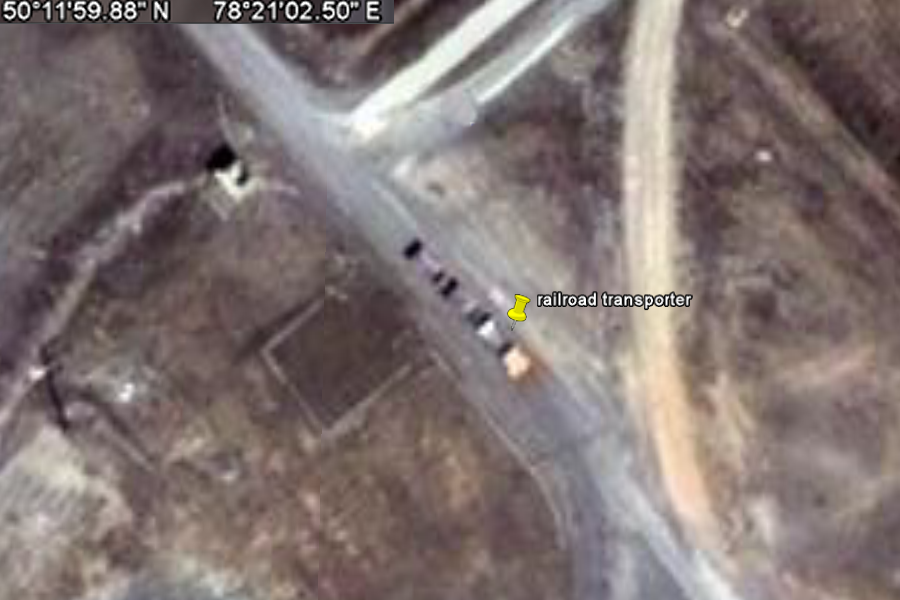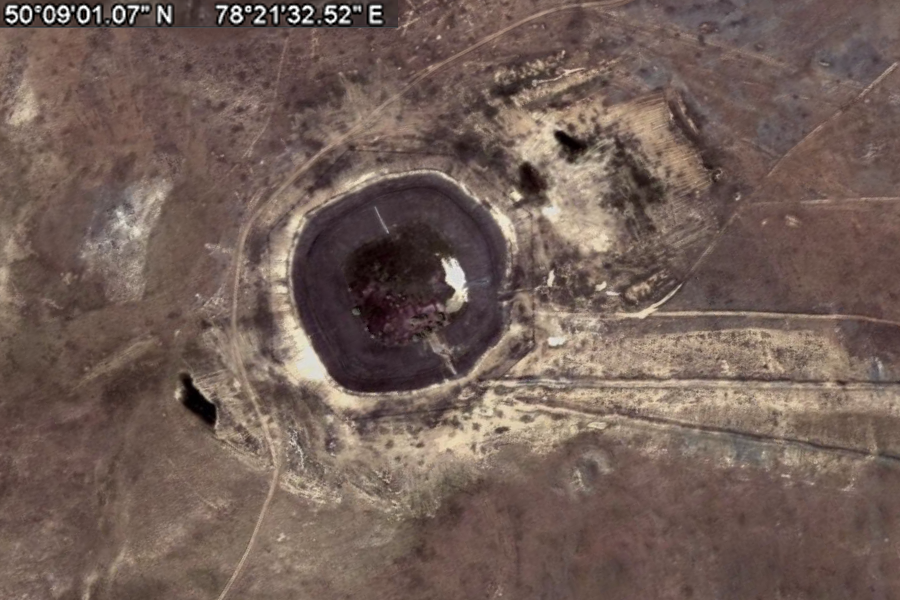|
|
|||||||
|
Baikal-1, Semipalatinsk, Kazakhstan 50°10'12.69"N, 78°22'36.84"W ..
Published July 28, 1980. (Courtesy Aviation Week & Space Technology) Related Links: |
|||||||
|
Baikal-1, Semipalatinsk, Kazakhstan (URDF-3) ..
Space Nuclear Facility test capability
at the Baikal-1 and IGR sites
Hill, T. J.; Stanley, M. L.; Martinell, J. S.
The International Space Technology Assessment Program was established 1/19/92 to take advantage of the availability of Russian space technology and hardware. DOE had two delegations visit CIS and assess its space nuclear power and propulsion technologies. The visit coincided with the Conference on Nuclear Power Engineering in Space Nuclear Rocket Engines at Semipalatinsk-21 (Kurchatov, Kazakhstan) on Sept. 22-25, 1992. Reactor facilities assessed in Semipalatinski-21 included the IVG-1 reactor (a nuclear furnace, which has been modified and now called IVG-1M), the RA reactor, and the Impulse Graphite Reactor (IGR), the CIS version of TREAT. Although the reactor facilities are being maintained satisfactorily, the support infrastructure appears to be degrading. The group assessment is based on two half-day tours of the Baikals-1 test facility and a brief (2 hr) tour of IGR; because of limited time and the large size of the tour group, it was impossible to obtain answers to all prepared questions. Potential benefit is that CIS fuels and facilities may permit USA to conduct a lower priced space nuclear propulsion program while achieving higher performance capability faster, and immediate access to test facilities that cannot be available in this country for 5 years. Information needs to be obtained about available data acquisition capability, accuracy, frequency response, and number of channels. Potential areas of interest with broad application in the U.S. nuclear industry are listed. SOURCE: Harvard Abstarcts
Upgrade of the IVG.1M reactor for testing of NPS and NPPS components V. Smetannikov[1], Yu. Cherepnin1, Ye. Romadova1, A. Kolodeshnikov[2], Yu. Vasilyev[2]
Abstract
The creation of continuously operating orbital space power platforms‚ planet-based power plants (for the lunar and Martian stations)‚ as well as propulsion power systems for interorbital transportation of spacecraft using both electrical rocket engines and engines based on thermal jet propulsion is topical today for the solution of tasks in circumterrestrial space and deep space exploration tasks. One of the most promising directions in development of nuclear power in space is the creation of nuclear power and nuclear power propulsion systems (NPS and NPPS) based on a fast gas-cooled high-temperature reactor with turbo-machine energy conversion using the gas Brayton cycle. Implementation of large-scale space projects is very expensive. In this connection, it will be reasonable to unite the efforts of states with developed space and nuclear technologies and infrastructures. The current period in the development of innovative technologies is characterized by the renewed state interest of Russia and the Republic of Kazakhstan in exploration of space. Any space nuclear power system cannot be created without conducting a complex of land-based tests. At the same time, the IVG.1M reactor located in Kazakhstan is a unique experimental tool for trials of the NPS and NPPS reactors with turbo-machine energy conversion. Currently, scientists of Russia and the Republic of Kazakhstan have embarked upon the practical work to upgrade the IVG.1M reactor. Among other things, this includes the creation of a gas-cooled loop facility provided with a closed gas exhaust system to test the NPS and NPPS components. During 1975-1990, large-scale tests of fuel assemblies were undertaken at the IVG.1 reactor as part of the Soviet Union’s effort to build a nuclear rocket engine. At present time, work is underway to upgrade the reactor systems to enable future tests of high-temperature gascooled fuel assemblies within the framework of the new space exploration tasks. The report will present the basic characteristics of the upgraded reactor and the available testing modes. SOURCE: http://www.inspi.ufl.edu/space07/program/abstracts/2022.pdf
Related Links:
Kazakhstan: Institute of Atomic Energy To return to the main reactor page, see the Kazakhstan: Reactors Overview file. LOCATION: Kurchatov, East Kazakhstan Oblast, former
Semipalatinsk
Test Site
BAYKAL-1 (BAIKAL) RESEARCH REACTOR COMPLEX LOCATION: Semipalatinsk
Test Site
Sources:
The Baykal-1 complex houses two research reactors (IVG-1M and RA) and one subcritical assembly (Angara). During the Soviet era, the Baykal-1 reactor complex was a branch of Luch Scientific Production Association set up to test fuel elements of experimental nuclear rocket engines and fuel assemblies.[1] According to Yuriy Cherepnin, General Director of the National Nuclear Center of Kazakhstan, nuclear projects have accounted for no more than half of the activities at the test site since 1980.[2] The Soviet nuclear rocket engine program ended in the late 1980s, and today, funding for Baykal-1 comes primarily from the Kazakhstani government.[3] A photograph of the Baykal facility is available, excerpted from a September 1997 presentation by Dr. Yuriy Cherepnin. Sources:
According to one source, three fresh fuel assemblies, each containing 200g of 90% HEU, are stored at Baykal-1.[1] Another source indicates that all fresh fuel (64 non-irradiated fuel assemblies containing 44kg of U-235) was returned to Russia by May 1998.[2] Sources:
MPC&A:
Under the DOE MPC&A program, US specialists provided the Baykal-1 Reactor Complex with material accounting software and provided assistance in developing comprehensive MC&A procedures.[1] Physical protection upgrades, including metal and nuclear material detectors, hardened portals and access points, and alarm and communications systems, were also implemented.[2] The three-kilometer perimeter of the Baykal-1 facility is fenced and patrolled by a guard force from the Ministry of Internal Affairs. There have been no attempted thefts of material from this facility.[3] (Please click the links for photographs of the fences and microwave detection system at Baykal-1.) According to the US Department of Energy, all MPC&A upgrades were completed and the site was commissioned on 13 September 1997.[1] For more information on the MPC&A work performed at this site, please see DOE's September 1998 document, Partnership for Nuclear Security: United States/ Former Soviet Union Program of Cooperation on Nuclear Material Protection, Control, and Accounting. Sources:
Kazakhstan: Semipalatinsk Test Site Semipalatinsk Test Site facilities are under the jurisdiction of the National Nuclear Center of the Republic of Kazakhstan, which is involved in civilian activities and conversion of the site to non-defense uses. The National Nuclear Center includes three research institutes in the town of Kurchatov and three research reactors at the Semipalatinsk test site. For information on these reactors and associated facilities please see Kazakhstan: Research Facilities. For more information on testing activities please see the brochure on Semipalatinsk prepared for the Second International Conference on Nuclear Non-Proliferation (September 1998), and the abstracts of the proceedings of the conference. The Semipalatinsk test range, covering an area of 18,000 sq. km, was officially closed by President Nazarbayev on 29 August 1991.[1,2] Between 1949 and 1989, 456 nuclear tests, including 340 underground and 116 atmospheric tests, were conducted at Semipalatinsk Test Site facilities.[3] Semipalatinsk's Degelen Mountain nuclear test facility (located at test site G, in the southern portion of the test site), was the largest underground nuclear test site in the world, consisting of 186 separate tunnels in natural mountain formations. Between 11 October 1961 and 10 October 1989, 224 tests were conducted there. Aside from Degelen Mountain, underground tests were also conducted at Balapan, in vertical holes drilled in the ground rather than in tunnels. These holes are about 500-600 meters deep and the bottoms of the holes are up to 900 meters in diameter. The last nuclear test conducted at the Semipalatinsk Test Site took place at Balapan in November 1989.[4] From 1997-2000, a series of calibrated explosions destroyed testing infrastructure at Degelen and Balapan as part of a joint US-Kazakhstan effort under the Weapons of Mass Destruction Elimination Initiative, Cooperative Threat Reduction program. For more information on the explosions, see the entries for 10/3/95, 9/21/98, 9/25/99, and 7/29/2000 in the Semipalatinsk: Developments section of the NIS Profiles database. There are no fences around the perimeter of Semipalatinsk; people and animals roam freely across the former test site. Only the Baykal-1 and IGR research reactor complexes are cordoned off, according to National Nuclear Center officials. According to Kazakhstani nuclear physicists, extensive mining operations are underway at the test site: beryllium, coal, and gold are mined and table salt is produced from a lake located near the main test field. In addition, scrap metal is gathered illegally from the site. According to some reports, bore holes at Degelen Mountain have been breached by scrap metal gatherers, although National Nuclear Center officials deny this.[5] For additional information on Semipalatinsk, see Conversion of the Semipalatinsk Test Site, a presentation given by Dr. Yuriy Cherepnin in September 1997 at Semipalatinsk. Sources:
For more recent developments, see the Semipalatinsk Test Site Developments file. Comments or questions? Contact Kenley Butler at MIIS CNS: Kenley.Butler@miis.edu SOURCE: NTI Kazakhstan: Semipalatinsk Test Site
..
|
|||||||
| URDF-3 Beam Weapons, ESP, and
Nuclear Rockets
From: admiraltogo 03/10/09 05:09 AM Fort Smith, AR bbs.keyhole.com/Number=1205026 URDF-3 (Unidentified Research and Development Facility-3, the CIA designation, I think the Russian name is Baikal-1) was the subject of some of the strangest US "intelligence" work of the cold war. It is a classic example of how secrets between governments can get out of control. The facility was located by satellite photographs in the vast Semipalatinsk-21 nuclear test site (the Russian NTS) in 1973, and had been identified as a facility to develop giant anti-rocket/satellite beam weapons by US Air Force Intelligence. This led to Major General Keegan in the US to proclaim that there was a "beam weapon gap" between the US and USSR. The CIA even used ESP (called "remote viewing") in Project Stargate to try to get to the bottom of what was happening at URDF-3 (you can't make this stuff up!). The reality is that this facility is the Russian equivalent of the US NERVA nuclear rocket program (the location of and function of the facilities I have posted previously). An example of one of the rocket engines developed is shown below:
Engine Model: RD-0410. Manufacturer Name: RD-0410. Government Designation: 11B91. Designer: Kosberg. Developed in: 1965-94. Application: Experimental nuclear engine. Propellants: Nuclear/LH2. Thrust(vac): 35.300 kN (7,936 lbf). Isp: 910 sec. Burn time: 3,600 sec. Mass Engine: 2,000 kg (4,400 lb). Diameter: 1.60 m (5.20 ft). Length: 3.50 m (11.40 ft). Chambers: 1. Thrust to Weight Ratio: 1.80. Country: Russia. Status: Developed 1965-94. The story of the giant beam weapon was so wildly known (even in the USSR) that, " ... many young Russian scientists in the 1980s were thrilled to be sent to Semipalatinsk, where they assumed they would be working on "Keegan's beam" ... Apparently they were disappointed that it did not exist. Consequently, morale suffered." The reality was that what they thought was beam weapons
were nuclear rocket test stands. What they thought was a nuclear accelerator
building, was a reactor assembly and test facility (just like the R-Mad
at NTS). What they thought were nuclear pulse generators were in fact liquid
hydrogen storage tanks (just like the large tanks still to been seen at
Test Stand "C" at NTS). The last observation that "proved" that this was
a beam weapon site speaks for itself:
"There is now no doubt that there is dumping of energy taking place at the site, with burning of large hydrogen flames." They were dumping energy all right... from nuclear rockets (along with radiation....)! What?s really funny about all this is that if these same people had seen photos of our test facility at NTS, would they have come to the same conclusion? Who knows what large beam weapon projects in the US were justified by the false conclusion about this site. The real reason was nuclear rockets, which just like the US version were intended for advanced space projects, like a Mars mission. The Russians tested nuclear rockets into the 1980's at this site. It looks like much of the facility has been disassembled so how did I know where it was? The CIA's report on some aspects of Project Star Gate is now declassified and available to read: CIA report dated Dec. 4th 1975 CIA-RDP96-00791R000200240001-0. It records the lat. and long. of the facility in question which I now pass on to all. Truth is often stranger then fiction. admiraltogo
Attachments
|
|||||||
| spotter2 03/10/09 09:02 AM
California, USA bbs.keyhole.com/Number=1205026 Great post, and a fascinating subject. I have to say this, most animals will not defecate
where they sleep, they put their waste elsewhere, human beings are the
only animals who completely, utterly destroy the environment where they
live. This is yet another case where the entire area is so grossly contaminated
it should be excavated down to bedrock, but the process of cleaning it
up will wind up killing untold numbers of workmen.
I don't see any rocket engine test stands or scorching
from a horizontal exhaust plume in this area, if they were building a nuclear
rocket here they must've been taking it elsewhere for actual testing. There
are several large and small bunkers in the area, but there's a lot of exposed
and unprotected equipment and structures around, it looks like they didn't
worry that whatever they were building here would explode or anything.
Some of the equipment looks like it's designed to handle large volumes
of highly compressed gases, but surprising little electrical power was
being used here, there isn't even a separate transformer substation. |
|||||||
| spotter2 03/10/09 10:09 AM
California, USA bbs.keyhole.com/Number=1205026 Oh, by the way, the picture of the nuclear engine. It seems to me that the tubular frame holding the engine is VERY flimsy, like the engine is extremely light. I don't see how that could be if there was radiation shielding, high volume pumps and pipes and the very heavy core assembly we used in the American engine. And it's so top heavy with that narrow base of the frame, trying to move it around would be very risky. And I don't see any places to attach hooks and straps to move it around, it's very delicate with all that exposed plumbing, how did they move it? It just strikes me as a fake, unless of course, it was built like our Pluto project, as a aircraft engine, and once you start it up it's going to be so intensely radioactive you don't even think of going anywhere near it! |
|||||||
| admiraltogo 03/10/09 02:48 PM
Fort Smith, AR bbs.keyhole.com/Number=1205026 Per Spotter2's comments I looked for conformation that this is Baikal-1, used for the Russian Nuclear rocket program. What I found surprised even me. First of all, one of the things we knew this site had to have is a very large gantry crane. It was one of the features the "remote viewers" got right, and I have seen numerous drawings of it based on the CIA over-fly photos, see below:  (I wish I had the orginal photo...). Looking at the site,
sure enough there is a large crane which I have marked (see attachment).
The shadow looks just like the drawings I have seen of the one at URDF-3.
Now having a large crane is not all that special (which is why the "remote
viewing" it was not all that amazing), but this one straddles two buildings
that could be the E-MAD and R-MAD (Engine and Reactor Maintenance and Disassembly)
buildings. Could it be that they hoisted the reactors out of the buildings
then traveled to test stands further down on the crane path, rather then
use rail cars like the US version? Could be, and then there is the biggest
surprise. Baikal-1 is still in use today. They have modified one of the
old nuclear rocket reactors from gas to water-cooling and use it for material
testing and they have a picture on a website. The Picture is so low res.
it about drove me mad, but it does show two buildings that match the two
white "E-MAD and R-Mad" buildings you can see next to the crane.
This reactor is called the IVG.1M, and is currently being used to test materials for the upcoming ITER (International Thermonuclear Experimental Reactor). Per Spotter2's comment on the Nuclear Rocket motor looking flimsy, that may be true. I looked at some different source material, and that example may have been a test motor equipped with an electric heater to simulate a reactor's heat rather then the real thing. However it would not have looked too different, this example also lacked the nozzle (removed due the room size where it is displayed) also, but the bulge below the cylinder of the "reactor" is the shielding. In both the Russian and US versions of NERVA type rockets the bulk of the propellant tank was supposed to make up for lack of shielding. I will keep looking for an image of this site in its "glory" days.
|
|||||||
| spotter2 03/10/09 04:44 PM
California, USA bbs.keyhole.com/Number=1205026 Fascinating! I agree, this is looking more and more like a partially automated assembly area. The gantry is parked on the far right side of its track, it straddles the structures and moves to the shielded round grey and red pits to the left, lifting and transporting the radioactive components, to the white building, that must be the actual assembly building, probably using remote manipulators. Notice the two round openings in the roof of the white structure for lowering the components into the building. Sure does look like an outdoor/indoor "hot" handling and assembly area for nuclear materials. I followed the railroad tracks, they go to a low resolution area, it's the same area where atomic bomb tests were conducted. And look what I found parked on the tracks along the way.
|
|||||||
|
....
.. |
|||||||
| FAIR USE NOTICE: This page contains copyrighted material the use of which has not been specifically authorized by the copyright owner. Pegasus Research Consortium distributes this material without profit to those who have expressed a prior interest in receiving the included information for research and educational purposes. We believe this constitutes a fair use of any such copyrighted material as provided for in 17 U.S.C § 107. If you wish to use copyrighted material from this site for purposes of your own that go beyond fair use, you must obtain permission from the copyright owner. | |||||||
|
|


